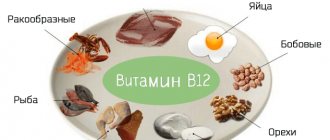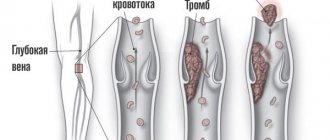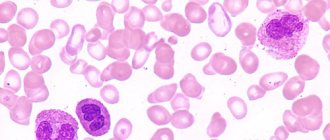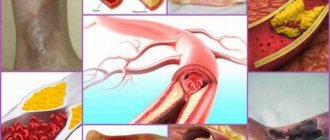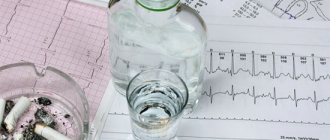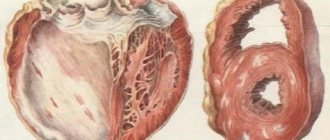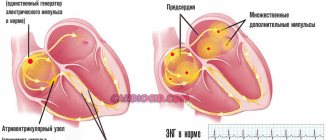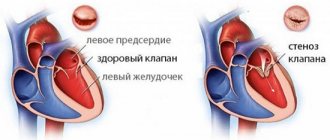The most severe disease of the pancreas is hemorrhagic pancreatic necrosis. This is the process of irreversible death of its cells, which occurs at high speed. The disease is a continuation of acute pancreatitis. Such pancreatitis occurs as a result of intoxication, mechanical damage, and complications after surgery. Pancreatic necrosis also appears from exacerbation of chronic diseases of the pancreas.
In a healthy person, the gland produces pancreatic juice, which processes proteins for the digestive system. The enzymes in the juice are removed from the pancreas into the duodenum. If the production of these enzymes by secretions is disrupted, their uncontrolled accumulation occurs, which leads to self-destruction of the pancreas. Tissues and blood vessels are damaged. Hemorrhages appear. Soon, dead cells occupy more and more areas (necrosis). The speed of the processes depends on the degree of production of excess enzymes.
This pathology affects the normal functioning of the entire body. The digestive system is upset, the immune system is sharply reduced. Medical statistics show disappointing data. Hemorrhagic pancreatic necrosis is the cause of death in 7–15 percent of cases when it is diagnosed.
Causes of the disease
The medical theory of the occurrence of this dangerous disease has not reached a consensus on the causes that cause it. But medical practice suggests that the following factors provoke the appearance of hemorrhagic pancreatic necrosis:
- if inflammation of the pancreas has previously occurred, which led to a partial loss of its functions,
- if the output of pancreatic juice is impaired,
- if there has been global poisoning due to alcohol or chemicals,
- if infectious diseases of the bile ducts have occurred: cholangitis, cholecystitis, etc.,
- if blood clotting increases as a result of past viral diseases, therapeutic effects using chemicals,
- if the body has autoimmune pathologies of the hemorrhagic type,
- if the parenchyma of the gland is injured due to mechanical actions, for example, surgical penetrations,
- if oncology was treated with chemotherapy or radiation, and against this background DIC syndrome occurred.
These reasons disrupt the functioning of the acinus, which is responsible for the production of enzymes. Gastroenterologists have revealed from the results of studies that one of the important roles in the occurrence of pancreatic necrosis is played by a violation of humoral regulation. This function controls human life through blood, lymph, and other liquid media with the help of hormones
Life forecast
Hemorrhagic pancreatic necrosis has an extremely unfavorable prognosis. Even with timely initiation of treatment, the death of the patient is observed in half of the cases. If you refuse therapy, this figure approaches 100%.
Causes of death
The main causes of sudden, sudden death in pancreatic necrosis:
- septic complications that impair the functions of all organs;
- infectious-toxic shock, due to which infection is considered a negative factor in the course of the pathology;
- irreversible change in the structure of the pancreas;
- total tissue necrosis;
- reactive changes in affected tissues.
In the situations described above, death occurs instantly or after a few days. It is extremely rare for a patient to survive more than 2 weeks.
Symptoms of pathology
The danger of the pathology lies in the fact that with this disease there are quite specific signs by which it can be diagnosed with a high probability. The problem is that hemorrhagic pancreatic necrosis develops very quickly, and patients end up in the hospital late. And in this situation, even modern treatment methods cannot help. One out of five patients collapses, and a third of them fall into a coma. Pancreatic tissue is especially often ruptured. Pancreatic juice ends up in the abdominal cavity and causes purulent peritonitis. To avoid the worst, you need to know the symptoms that are inherent in pancreatic necrosis:
- severe pain in the left hypochondrium, which can radiate to the chest and shoulders, and to the lower back,
- the appearance of a clear coating on the tongue, which is colored white or yellow,
- unbearable dry mouth, which is impossible to get rid of,
- continuous vomiting, nausea,
- flatulence,
- diarrhea,
- feverish state due to severe poisoning,
- temperature increase,
- inflammation of the skin around the face,
- blue belly,
- blood pressure disorder,
- a sharp decrease in the functioning of the excretory system (urine, feces),
- threshold levels of psycho-emotional state (depression, aggressiveness).
Pain in the left hypochondrium
Mortality and prognosis
Mortality from hemorrhagic pancreatic necrosis is 7-15%, in severe cases - 40-70%. The disease leads not only to disruption of the functioning of the pancreas, but also of the entire body. The patient's immunity decreases and the digestion process is disrupted.
Hemorrhagic pancreatic necrosis can cause necrosis of cells of other organs that are located near the pancreas.
The most common cause of death from this disease is intoxication of the body due to purulent peritonitis.
The prognosis for recovery is favorable only with early treatment to the hospital and correct therapy. After treatment, you need to follow a diet and give up bad habits.
Diagnosis of the disease
Only doctors can make an accurate diagnosis after a comprehensive examination: computer diagnostics, laboratory tests. If hemorrhagic pancreatic necrosis is suspected, the following are prescribed:
- Ultrasound of the pancreas,
- CT scan of the entire abdominal organs,
- MRI,
- standard blood tests, urine tests,
- determination of the composition of pancreatic and gastric juices.
The blood is assessed for the content of enzymes produced by the gland. In urine, pay attention to the concentration of trypsinogen and amylase. The acidity of gastric juice, the amount of enzymes in pancreatic juice, fats in feces, and triglycerides in the lungs are also important. It may be necessary to remove dead tissue.
The totality of the results obtained will help to distinguish this disease from other acute pathologies of the stomach and intestines. In some cases, patients arrive at a medical facility in such a condition that they immediately have to undergo laparoscopy without preliminary research.
Manifestations of pancreatic necrosis
The development of the disease occurs in stages:
- The first is that bacteria actively develop in the pancreas, causing toxinemia and increased autoaggression of pancreatic enzymes. Fever, vomiting, and unstable stools begin.
- The second - purulent and enzymatic breakdown of gland cells begins, with the formation of failures in the organ.
- Third, inflammation spreads to neighboring tissues, causing a stress response in the body.
It manifests itself as acute girdling pain, radiating to the left side of the body. This disease does not exist without pain. Accompanied by uncontrollable vomiting, which does not bring relief, with the release of bile and blood particles. Dehydration develops, the skin and mucous membranes dry out, the tongue becomes coated, and the volume of urine decreases. Gas formation increases and stool becomes irregular.
When examining the patient, bloating is observed in the abdomen, and blue or purple spots also appear on the sides, around the navel, and on the buttocks. This is a sign of bleeding in the gastrointestinal tract, as elastase (an enzyme) destroys blood vessels.
Treatment of the disease
If a person develops an acute stage of hemorrhagic pancreatic necrosis, hospitalization is mandatory. The use of self-treatment is even more dangerous. The cause of death will be untimely medical intervention. With this diagnosis, there are two options: the patient ends up in the intensive care unit or on the operating table. General therapy performs the following tasks:
- acute pain is relieved,
- excessive production of pancreatic enzymes stops,
- spasms are relieved,
- the secretion of gastric juice decreases,
- infection is prevented.
Resuscitation measures must be applied without delay. Antispasmodics are used. Novocain has a quick effect. The ducts dilate and pancreatic juice is excreted unhindered. From the first hours, anti-enzyme and antibacterial drugs are used, secretory function is reduced and tissue necrosis is prevented.
After several hours of such therapy, doctors look at its effectiveness and weigh the pros and cons. A decision is made about the need for surgical intervention. If the form of the disease is not infectious, then the use of laparoscopy is indicated. It is possible to use drainage of the cavity through the skin. If abundant exudate is detected, then it is necessary to perform an operation on the cavity. A positive effect will follow from the peritoneal dialysis procedure. Thanks to it, enzymes and toxic substances are removed from the blood, sharply reducing the risk of death.
With widespread pancreatic necrosis, partial removal of the pancreas (rarely complete) may be necessary. Immediately after surgery, usual treatment is prescribed. In this case, medications that specialize in maintaining the functioning of the gland become mandatory.
Therapy
The first thing the patient needs is adequate pain relief and control of shock. To do this, the patient is injected with electrolyte solutions and protein blood products (Polyglukin, Reopoliglyukin, Hemodez, plasma and albumin). For pain relief, narcotic analgesics (Promedol, Diazepam) are used. In some cases, they are supplemented with 1st generation antihistamines, which have not only an antiallergic but also a sedative effect.
A mandatory point of therapy is to relieve sphincter spasm. For this purpose, antispasmodics are used (Platifillin, Papaverine, Eufillin). Severe vomiting can cause an electrolyte imbalance. Therefore, solutions of potassium, calcium, and magnesium are often administered to a patient in intensive care. They help normalize the functioning of the heart muscle.
To reduce the damaging effect of enzymes, drugs are administered that reduce the effect of proteases (Trasylol, Contrical). Also, the activity of the gland is inhibited by hormonal drugs (Octreocid, Sandostatin). They reduce the area of necrosis. With their prophylactic administration during manipulation of the gland, the aggression of enzymes is reduced.
With pancreatic necrosis, the process spreads beyond the organ, forming lesions in the surrounding tissues. Therefore, surgical treatment for this type of pancreatitis is a vital necessity. Extensive abdominal operations have a poor prognosis. Doctors prefer laparoscopic interventions. In this case, foci of necrosis are removed, and drainage tubes are inserted into the infiltrates.
In the case when all methods do not give the desired effect, death occurs. With this form of the disease, it can occur on the first day of the disease. With adequate treatment, but weak body defenses, patients die 1-2 weeks after the attack. The main causes of mortality are purulent-septic complications, pneumonia, multiple organ failure, and infectious-toxic shock. In surviving patients, pancreatic necrosis leads to disability.
Prevention of pathology
Recovery after surgery requires at least four months. In this case, special nutrition, rest with a minimum of stress and rehabilitation therapy are indicated. A course of taking insulin tablets, enzyme medications, and physiotherapy is prescribed.
A therapeutic diet with restrictions must be followed throughout life. Food is taken 5-6 times a day in small portions. The appointment times are the same. It is recommended to boil or steam vegetables. Porridge only with water, low-fat fermented milk products. Poultry is recommended for meat. It is prohibited to eat fresh fruits and vegetables, fast food, alcoholic beverages, milk, and canned food.
To prevent the occurrence of hemorrhagic pancreatic necrosis, it is necessary to follow simple rules of a healthy lifestyle. Eat more fresh vegetables and fruits, whole grains, nuts, vegetable oils, and seafood. Avoid fatty foods, processed foods, large amounts of sugar and salt. Drink more clean water. Quit smoking, don't abuse alcohol, move around and be in the fresh air more often. Avoid stressful situations and undergo regular medical examinations.
